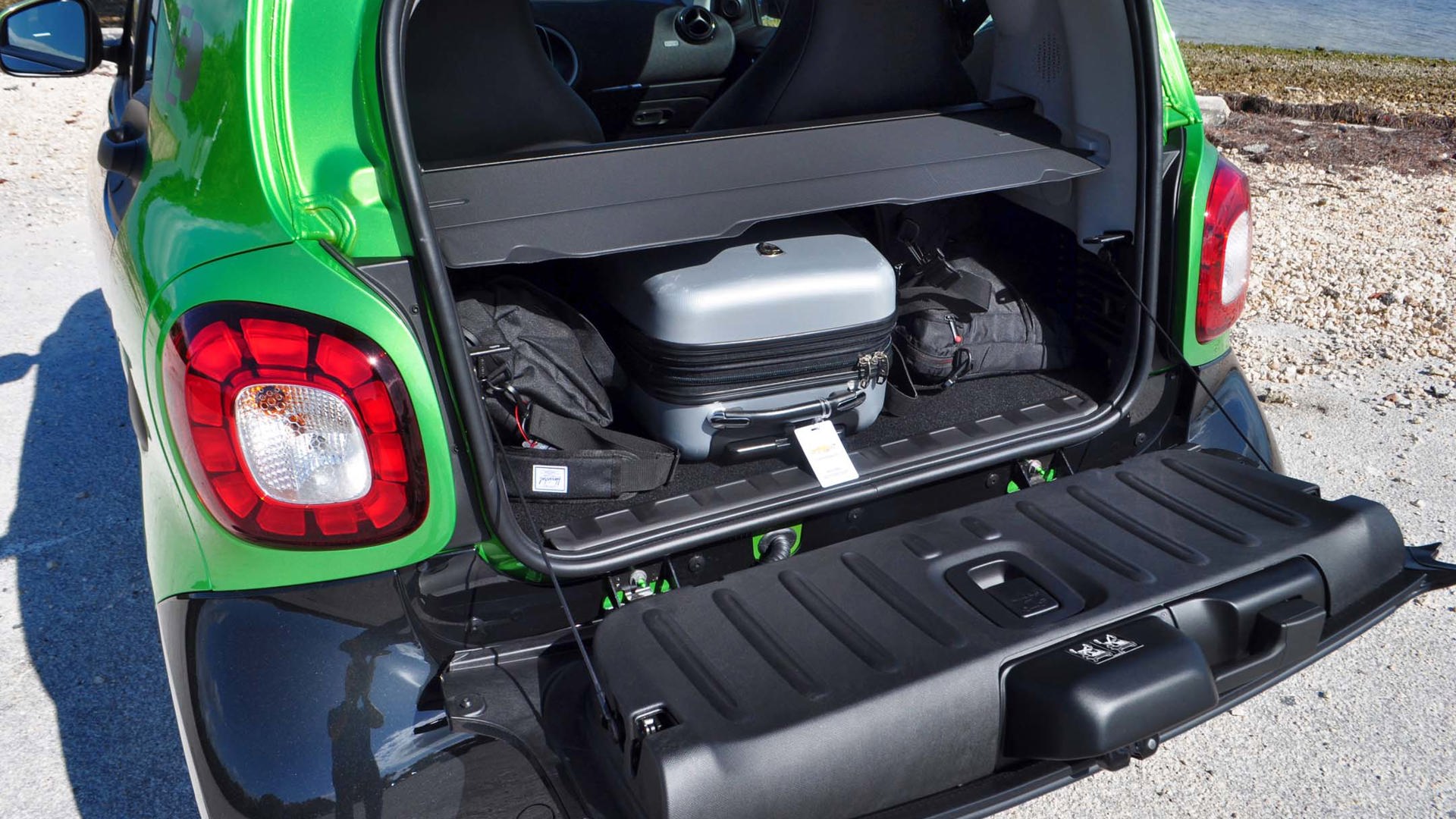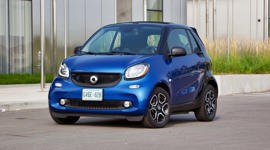Miami, FL – When the super-quiet Smart ForTwo Electric Drive arrived in Canada for 2013, it instantly cured the micro two-seater’s biggest flaw: its see-saw, grab-the-Gravol, head-bucking semi-automatic transmission. The electric ForTwo became the unquestioned no-brainer in Smart car desirability.
One of the challenges for battery electric vehicles in Canada is that they can easily lose 20 to 40 percent of their already limited driving range in deep winter.
If you wanted a Smart, you wanted a smooth and silent EV version. Especially in rebate provinces that offered big electric car incentives, which either approached or wiped out the roughly $6,000 price premium over the top gas version.
Which brings us to this here, the all-new Smart EV, and down to the southern tip of Florida to enjoy the type of weather that EVs, and EV owners, enjoy so much. For another one of the challenges for battery electric vehicles in Canada is that they can easily lose 20 to 40 percent of their already limited driving range in deep winter. And despite many improvements over the last electric Smart, even its battery development manager, Dr. Wolfgang Neher, conceded that sub-zero temperatures remain a challenge.
“Ambient temperatures are still an issue,” he admitted, when asked about how much range is reduced by winter conditions in Canada – and not in Vancouver. He noted that the degree always varies, based on how cold it is outside, and how warm folks want it inside, as both measures greatly affect overall range, as well as the usual suspects that affect gas car fuel consumption too: aggressive acceleration and high speeds.
Vehicle improvements plus increased government inducements key here
But before deep-diving into its details, it’s worth looking at the overall picture. The electric Smart will offer a host of upgrades over its EV predecessor, the main ones consisting of much better acceleration, slightly more range, and faster Level 2 (240V) charging capability. However, since the new generation premium gas-powered Smart introduced for the 2016 model year tamed its transmission to (nearly) civilized levels, the refinement and driving pleasure gap has narrowed, though is still very much in the electric Smart’s favour.
Perhaps even more enticing than such notable but relatively minor improvements are the investments that various provinces and the federal government are making towards luring car buyers into the plug-in vehicle market, especially in Ontario. This has largely been with increased funds for EV charging stations at the federal level, and in Ontario’s case, greater financial incentives to go with a rapid increase in planned charger installations by the end of March 2017 – right around when the Smart Electric Drive is set to arrive.
New Ontario financial incentives go beyond the increased purchase rebates offered by the province, which have increased to a maximum of $14,000 for plug-in vehicles with large batteries and five seats or more. The Ontario government’s five-year Climate Change Action Plan details these further measures in its transportation section, the highlights of which will be a method to provide free or subsidized overnight charging for plug-in vehicle owners starting in 2017, and working with the federal government to study ways to eliminate the entire HST on new battery electric vehicles (BEV) such as the Smart ED by 2018.
Plus keep in mind that starting January 2017, every litre of fuel sold in the province will be subject to the new provincial carbon tax, which the government estimates will add 4.3 cents to each litre of fuel burned. These are extra costs obviously not felt by BEV drivers, and in fact the proceeds from this carbon tax will go towards the new “Green Bank” that pays for these plug-in rebates and new public charging stations and other climate-related initiatives.
It’s all of these inducements put together that will help entice mainstream Canadian drivers across the country to at least peer over the higher initial price wall, and consider life on electric avenue.
Major acceleration improvement, but still no blazing sport coupe
As for the car itself, don’t let the two doors or rear-wheel drive fool you. Clearly, this is no performance machine.
At 11.5 seconds for its 0–100 km/h sprint, the Smart ED’s acceleration is distinctly of the “whoa-then-wait” variety. Mercedes-Benz officials were quick to point out that the BEV Smart’s 0–60 km/h time is only 4.9 seconds, a figure which lays bare how the Smart’s hefty 118 lb-ft of low-end oomph comes in as soon as you put your foot down. But this figure combined with its 0–100 km/h time also highlights how that instant urge soon tapers off, as it meekly makes its way up to the Smart ED’s 130 km/h top speed.
It’s still a major improvement over the mid-14 second range its predecessor took to trundle its way up to highway speed. That car was so lethargic that when I first sampled it years ago, I could have sworn the parking brake was still applied. So the new Smart EV is much better, but it’s still one of the slowest vehicles out there at this particular benchmark test, and about a half-second slower than its 70-ish kg-lighter, 89 hp gas-powered city-car sibling.
Buyers will more likely be more interested in the Smart ED’s increased range. It’s not nearly as much of an improvement, and hasn’t been officially confirmed in realistic EPA/Natural Resources Canada numbers, where the 2015 model achieved a range of 109 kilometres. Using optimistic European figures, its range has increased from 140 to 160 km now, and using a similar 10 percent increase, its real-world range should hit closer to 120 km in total.
Granted, it will certainly be lower than that in deep freeze conditions, but the electric Smart will come standard with heated seats and a heated steering wheel, plus a timer system where you can warm up the cabin while plugged in, so the driver can use grid power instead of precious battery power to warm up the cabin. All of these will help you increase winter range by minimizing the need to produce heat electrically – it may be inefficient, but that’s one thing that the internal combustion engine is good at: creating waste heat.
But even if you’re not plugged in, there’s an app coming to Canada mid-year that will allow you to warm or cool the cabin before you arrive to your car from your phone, tablet or desktop, for those times when you’re sure you have enough range for your needs.
Faster charging in North America, but sadly no DC quick charging
Since the 17.6 kilowatt-hour (kWh) battery is largely the same as before, it takes roughly the same time to recharge it from a regular 110 volt outlet as before: roughly 13 hours from a 20 percent charge using a typical 12 amp circuit. But if you’re using a 240 volt Level 2 charger at home, a highly recommended accessory for all BEV drivers, this time is cut down to a much more schedule-friendly 2.5 hours, thanks to the upgraded onboard charger from a 3.3 to a 7 kilowatt-system to slurp up those electrons faster.
These Level 2 stations typically cost between $500 and $1,000, and a similar amount for installation in most garages or driveway mountings, with rebates available from both Quebec and Ontario of up to $1,000 total to go towards these costs. But as a former BEV and now plug-in hybrid owner, these stations totally pay for themselves in convenience and vehicle usability over the years.
In Europe, Smart offers a 22 kW quick charger, which slashes recharging time to 45 minutes for an 80 percent charge. But sadly, the Smart ED doesn’t allow the North American equivalent – DC quick charging – which often tops up competing BEVs to about 80 percent charge from near empty in 30 minutes or less, depending on model.
Driving feel may be unique, but interior not so much
This electric Smart’s drivetrain is certainly a futuristic improvement in overall driving feel: creamy smoothness, off-the-line response, and largely silent operation. There’s a Star Wars-worthy whir only audible if you floor it away from traffic, and with the radio off.
The interior, on the other hand, is largely similar to its gas counterpart. Yes, there’s an extra state of charge gauge and integrated power meter, somewhat awkwardly stuck onto the top of the dash to the left of the steering wheel, plus the fancy “ED” logo that looks more like a plug and receptacle than two letters.
And yes, Smart officials had heard all the juvenile “ED” jokes when they decided to keep the name and short form.
Interior materials have taken a dramatic step up the refinement scale, with fun colours and shapes still in keeping with the tiny ForTwo’s bubbly personality. Automatic climate control and a height adjustable driver’s seat are standard, with an optional LED package (also includes cornering fog lights and rain sensor), a touchscreen package (larger 7-inch screen with rear back-up camera), and individual luxury (panoramic fixed sunroof, ambient lighting) and safety options (forward collision warning).
But for such a high-tech car, the act of needing to place a key into the “ignition” seems like a relic to earlier times. Which it is, as well as a cost-cutting measure to keep both EV and gas ForTwo steering columns the same.
There’s no pricing available on the options or the Smart ForTwo ED itself. Both coupe and convertible are slated to arrive in the spring, but curiously still as 2017 models.
Given that the price needle barely moved with the introduction of the new-generation gas Smart, it seems very reasonable to predict that the price won’t vary much from the $26,990 starting price for the last ED coupe, and $29,990 for the electric Smart droptop. Since Ontario revamped rebates depend somewhat on the cost of the car, now capped at 30 percent of the price of the car, they’re expected to remain close to the $8,500 mark, or $8,000 in the province of Quebec, and up to $8,250 in BC if you have an older “clunker” to take off the road at the same time.
Great city car, if you have a place to charge it
Looking at the entire package, I realized my driving partner on this preview drive just happened to be a near perfect demographic for the upcoming Smart ForTwo Electric Drive coupe: single urban professional, relatively young, no kids, living in the heart of Vancouver, where traffic and parking can be nightmarish, but with relatively mild winters. So would she buy one?
She’d stick with the gas one, she said, largely because she didn’t have a place to charge it. Her spot in her condo’s parking garage doesn’t have an outlet, and there are no provided communal chargers, as are starting to appear on newer condos there. This is also where a lack of DC quick charging hurts the Smart, as condo dwellers could pop by a quick charger for 30 minutes as part of a daily charging routine, though there’s no doubt that home charging is much more convenient overall.
When all is said and done, if you can charge it overnight, live in any of the rebate provinces, and do mainly city driving, there’s no question the upcoming 2017 Smart Electric Drive is the smartest Smart out there.

































